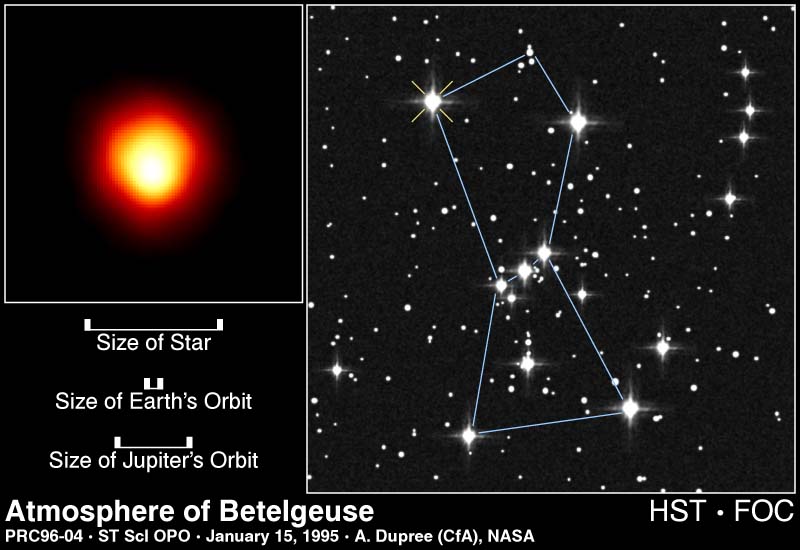
Caption: On the left is a resolved image of Betelgeuse from the Hubble Space Telescope (HST) and on the right is a non-HST wide-FOV image of constellation Orion (with Betelgeuse marked by an X mark). The lines joining the stars are NOT present on the sky, of course.
Features:
- Betelgeuse (α Ori)
is an M1-2 Ia-ab red supergiant star.
On the sky,
It is the eastern
shoulder of
the constellation
Orion: i.e., the
left
shoulder on the image.
In distance
it is 222(48) pc from the Sun.
- The
resolved image is a bit
hard to interpret.
It's probably false-color with
yellow being brighter
and red, dimmer.
The changing colors probably just
show the limb darkening.
- The
photospheric radius
is very uncertain---and so the
size given in the image is NOT definitive.
From modeling,
the photospheric radius
is known to be between 1.2 and 8.9 AU.
So it may be larger or smaller than
Jupiter's
mean orbital radius
5.2044 AU.
Beyond the photosphere
is Betelgeuse's
stellar atmosphere
(see Wikipedia: Betelgeuse: Diameter).
- Orion is
one of the three constellations anyone can
recognize--it is high overhead in the mid-winter
night sky---the
lord of the
winter
sky.
The other two are the Big Dipper (officially an asterism in Ursa Major) and Cassiopeia (the Big W). Both are in the northern sky and are circumpolar constellations for those at mid-northern latitudes and farther north. Hence, they are all-year constellations for those regions.
- The mythical Orion
is a giant
hunter
of Greek mythology:
he pursued the
mythical Pleiades
and
was slain by Artemis in some versions of the
myth.
Now the constellation
Orion
pursues the
Pleiades asterism (M45).
Image link: Itself.
Local file: local link: betelgeuse.html.
File: Star file: betelgeuse.html.